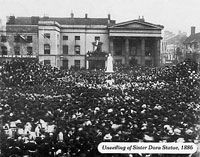Walsall in history

The earliest reference to Walsall was thought to be in a will dated c.1002-4 which refers to a place called 'Walesho', but this is debatable and requires further scrutiny. The place name of Walsall is now generally believed to derive from the Old English personal name 'Walh', thought to be from the Saxon term for a Briton or Welshman, and 'H(e)alh' meaning 'a sheltered place'. Walsall was omitted from the Domesday Book (1086) - perhaps due to a clerical error, though this is unknown.
The medieval town grew up in a cross shape, with the highest point, Church Hill, at its head, standing 511 feet above sea level. The other points of the cross reached down to Town End, and along Peal Street and Rushall Street. A church has stood on the hill since at least 1200 and the St. Matthew's Church, originally dedicated to All Saints, still contains a 13th century inner crypt. A market has been held in High Street since c.1220 and is still a popular attraction. Originally Walsall thrived as an important market town and had a primarily agricultural economy for many centuries. However, the Borough had good supplies of coal, ironstone and limestone, enabling metalwork industries to prosper, and light metalwork has been the traditional industry of Walsall since the 16th century or earlier. Bits, stirrups, buckles and spurs have been made locally for centuries, and from this lorinery trade developed the manufacture of saddlery and leather goods for which Walsall is famous.
The Industrial Revolution encouraged these small industries to grow on a huge scale. Transport systems developed to carry the coal and iron to customers nationwide; many foundries, ironworks and mines opened which exploited the development of local canal and railway networks to transport their heavy goods. The extraction of limestone, used in both industry and agriculture in large quantities, has left its legacy in the subsidence problems which have appeared in Walsall over the years. More positively, some quarries were flooded to create the Arboretum park lakes. The Arboretum was opened in 1874 and entrance charges were abolished in 1885 when it became a free public park.

The population of Walsall increased dramatically during the 19th century, doubling and then tripling, as people came to work in the town's prospering industries. Much of the housing, built in haste to accommodate the influx of workers, was of a poor standard and has since been demolished. Unfortunately, redevelopment during the last 150 years has resulted in most of Walsall's historic buildings being lost - many fine buildings along with the slums.
Famous inhabitants of Walsall include Jerome K. Jerome, the author of 'Three Men in a Boat' who was born in Belsize House, Bradford Street in 1859. Sister Dora was born Dorothy Wyndlow Pattison in Yorkshire in 1832. Her pioneering nursing work, as she developed Walsall Cottage Hospital, earned her national respect. She died in 1878 and eight years later a statue to her memory was unveiled on The Bridge. This was the first statue of a woman not of royal birth ever to be erected in Great Britain.
Walsall Local History Centre